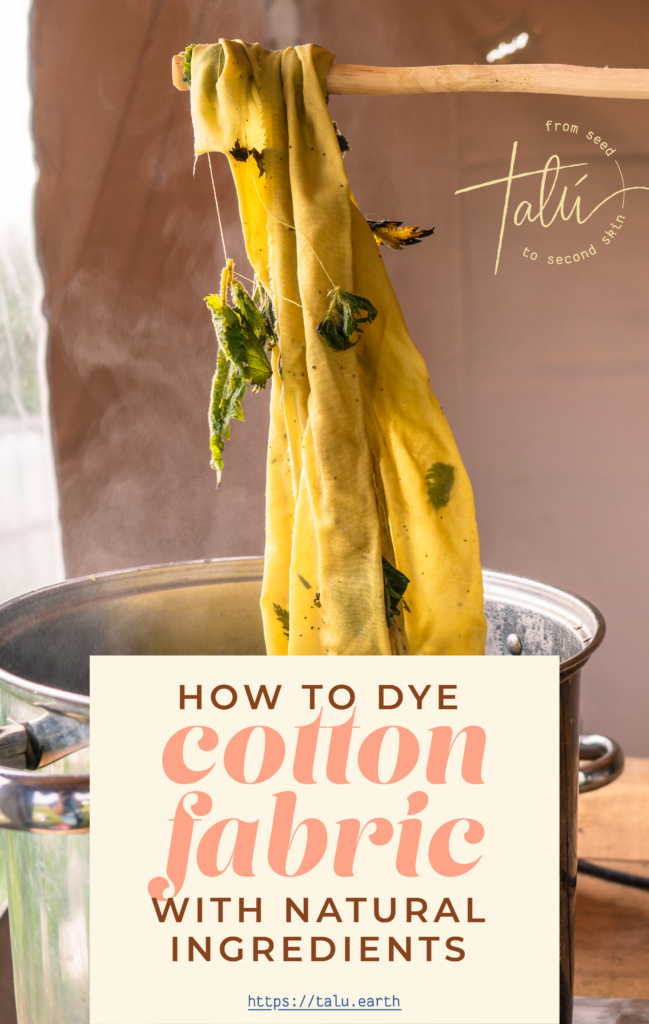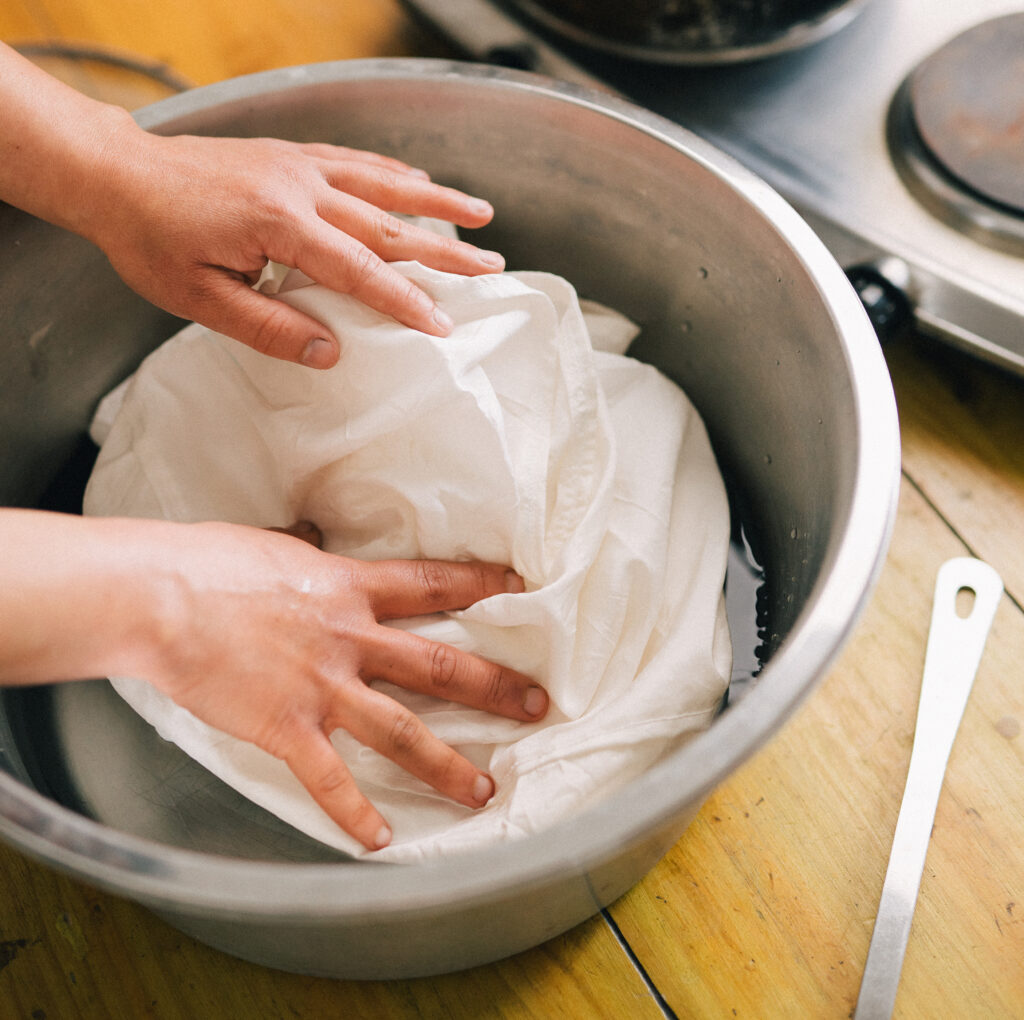Natural textile dyeing can begin to repair our relationship with the planet.
With the rise of fast fashion, the Land’s natural cycle of decomposition and regeneration has been disrupted. Learning how to dye cotton fabric with natural ingredients can help rebuild it.
It’s just one step in a sea of many that ultimately impact the planet, but it’s a fun one!
When natural, sustainable fibres are dyed with natural ingredients, the textiles can be composted! That means they can go right back to the land, returning energy and nutrients to the soil.
Natural dyeing also takes a stand against the environmental havoc of fast fashion. Clothing made intentionally and slowly can exist without harming people or planet, and that’s no easy feat.
So, why exactly is cotton a sustainable fabric?
Well, to put it simply, cotton does not contain plastics or overly rely on fossil fuels in its production. But that alone isn’t good enough to be a “sustainable” material.
Regular cotton uses chemicals and pesticides during production, requires a huge amount of water, and demands the clearing of soil, which decimates natural plant and animal biodiversity.
So, just because something is made out of cotton–a natural, vegan material–doesn’t mean it’s perfect.
Organic cotton, and cotton grown in native locations, is much better for the planet and the farmers growing it.
Cotton allowed to complete its full cycle of growth, harvesting, death, and decomposition actually increases soil health. Nutrients need to return to the soil, and over time, cycles of decay infuse the ground with nitrogen, carbon, and other necessary fertilisers.
Cotton grown in its native environment requires much less water than non-natively grown cotton. Generally, plants (and animals) survive most easily in the places where they naturally adapted and evolved to survive.
Native plants require less human intervention, because the earth itself can provide for them.
So, look for GOTS-Certified cotton for the most sustainable cotton textiles available!

What types of cotton fabrics are best for colour uptake?
All 100% cotton fabrics will dye beautifully as long as they don’t have any waterproofing treatments like wax coatings. However, bear in mind that the colours you achieve on fibres made from plants, such as cotton, will always be lighter than the colours you achieve on protein fibres such as silk. That’s just due to the makeup of their fibres!
But, fear not, with the proper techniques, you can achieve gorgeous colours on any kind of natural fibre!
100% natural cotton fibres include canvas, chambray, corduroy, just to name a few! For a more extensive list, see this 71-item threads monthly article.
What natural dye ingredients are best for cotton textiles?
Most natural dye ingredients will work well with cotton! So, learning how to dye cotton fabric is actually easier than you might think. It just requires patience!
But, specifically, dye ingredients with a high amount of tannins get along especially nicely with cotton fabrics.
There are many high-tannin vegetables and plants that can be used for dyeing cotton. Some of my favourites are fresh pomegranate peels, which will give a very bright shade of yellow and walnut husks, which will give a dark shade of brown.

You don’t have to exclusively use dyestuffs high in tannins. You can also use other reliable sources of colour to create some gorgeous hues. You can see my full list of plants you can use for natural textile dyeing on my website!
How do you prepare cotton fabric for dyeing?
I’m often asked about how to make clothes more colourfast, and the preparation steps of scouring and mordanting are the key. This means cleaning and impregnating the fabric with a specific technique that will help you get the best dyeing results.
You will need:
- Fibres you’ll dye
- Kitchen scales
- Two pots or heat-proof containers used specifically for dyeing
- Heat source
- Wooden spoon or stick, specifically for dyeing
- Neutral soap
- Soda ash
- Gloves and face mask
- Alum (Potassium aluminium sulphate) and a clear tannin extract – check out my blog post on where to buy natural dye supplies around the world if you’re unsure about where to get them
- Jars
For scouring:
- Weigh your dry cotton. Write down that weight – you’ll need it later! (WOF = Weight Of Fibre.)
- Fill in your pot with enough water so that the fibres can move around freely.
- Using GLOVES AND FACE MASK to manipulate the soda ash, add 10g of soda ash and 5mL or 5g of soft, pH-neutral detergent that’s free from any additives for each 200g of fibre. Dissolve thoroughly. You can start heating to make sure the soda ash dissolves completely.
- Add in the fibres and bring up to a simmer for at least two hours. With cellulose fibres you don’t need to worry about heating too much, but it’s not necessary to bring them to boiling point.
- Stir the fibres constantly and add more hot water if needed. Be careful to not breathe in the vapours directly when opening the pot.
- Let the water cool down and rinse the fibres. REMEMBER TO WEAR GLOVES TO TAKE THEM OFF THE POT!
- You can proceed directly to mordanting or let the fibres dry and mordant later.
- You can get rid of the remaining solution directly down the drain. If you used biodegradable soap, you can also add a splash of white vinegar to neutralise the soda ash and pour the water directly on the ground, just NOT on top of a plant and NEVER less than 60m from a body of water such as a lake, river or the sea.
For mordanting:
- If your fibres are dry, soak them for at least half an hour before treating them.
- Use the weight of fibre percentage (WOF) that the supplier of your clear tannin extract recommends. It’s normally around 10% of the weight of fibre. Put it in a jar and pour hot or boiling water to dissolve.
- In a heat-proof container such as a pot or bucket, add enough room temperature water to cover your fibres and the dissolved tannins from your jar. Add the fibres and leave to soak for at least two hours, stirring often. It’s much better if you can leave them overnight.
- Dissolve 15% of the weight of fibre (WOF) in alum in one jar, and in a different one, dissolve 1.5% of the weight of fibre (WOF) in soda ash, USING GLOVES AND FACE MASK. It’s very important that BOTH SOLUTIONS ARE SEPARATED.
- Once both metallic salts are thoroughly dissolved, add enough water to a second heat-proof container so that the fibres can move freely, just make sure the water is not too close to the rim.
- Pour in the diluted soda ash and stir in.
- Add in the diluted alum. It might bubble momentarily.
- Once the fizz subsides, add more water if needed to make sure the fibres are completely covered.
- Add your fibres directly from the tannin bath, without rinsing and leave them in the mordant bath for at least 2 hours, stirring often. Preferably, leave them to soak in the mordant bath overnight.
- Rinse lightly and proceed directly to dyeing or let dry away from direct sunlight.
You can dispose of the used-up solutions down the drain or directly on the ground, just NOT on top of a plant and NEVER less than 60m from a body of water such as a lake, river or the sea.
For dyeing:
I explain how to dye clothes a few times on my blog. To start, you can read about how to dye clothes pink naturally, which has a list of everything you will need and some general instructions. Be sure to dive deep into this post to see exactly what I mean!
Want to learn natural dyeing and how to dye cotton step by step?
I love colour, natural textiles, and learning how to contribute to the cycle of regenerative fashion with my clothing!
I’ve spent my life studying the intricacies of textile dyeing, and I’d love to impart my knowledge with like-minded creatives.
If you want to learn how to dye cotton fabric, and how to dye every other natural textile, my Living Colours with the Five Elements natural dyeing workshop will give you the tools and knowledge to go into these topics in depth.
I cover everything, from the basics of natural dyeing to the intricacies of colour uptake with different textures. I hope to see you there!
Pin this post!

